重庆医科大学:《诊断学》课程教学资源(授课教案)12 血管检查
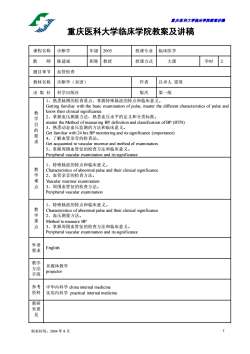
重庆医科大半临床半院载未讲满 重庆医科大学临床学院教案及讲稿 课程名称诊断学 年级2005 授课专业临床医学 教师陈建斌 职称教授 授课方式大课 学时2 题目章节血管检查 教材名称诊断学(双语》 作者吕卓人雷寒 出版社科学出版社 版次 第一版 1、熟悉脉搏的检查要点,掌握特殊脉波的特点和临床意义。 Getting familiar with the basic examination of pulse.master the different characteristics of pulse and 血压水平的定义和分类标准, Get familiar with 24 hrs BP monitoring and its significance (importance) 4、了解血管杂音的检查法。 特殊脉波的特点和临床意义。 教学 Vascular murmur examination 占 3、周围血管征的检查方法。 Peripheral vascular examination 1、特殊脉波的特点和临床意义。 教学 mdpanBardhdgiane 管征正的检查方法和临床意义。 Peripheral vascular examination and itssignificance 要求 English 数学 多媒体教学 手段 参书 资料 中华内科学 实用内科学practical 制表时间:2004年8月
重庆医科大学临床学院教案讲稿 制表时间:2004 年 8 月 1 重庆医科大学临床学院教案及讲稿 课程名称 诊断学 年级 2005 授课专业 临床医学 教 师 陈建斌 职称 教授 授课方式 大课 学时 2 题目章节 血管检查 教材名称 诊断学(双语) 作者 吕卓人 雷寒 出 版 社 科学出版社 版次 第一版 教 学 目 的 要 求 1、熟悉脉搏的检查要点,掌握特殊脉波的特点和临床意义。 Getting familiar with the basic examination of pulse, master the different characteristics of pulse and know their clinical significance. 2、掌握血压测量方法,熟悉血压水平的定义和分类标准。 master the Method of measuring BP, definition and classification of BP (HTN) 3、熟悉动态血压监测的方法和临床意义。 Get familiar with 24 hrs BP monitoring and its significance (importance) 4、了解血管杂音的检查法。 Get acquainted to vascular murmur and method of examination. 5、掌握周围血管征的检查方法和临床意义。 Peripheral vascular examination and its significance 教 学 难 点 1、特殊脉波的特点和临床意义。 Characteristics of abnormal pulse and their clinical significance 2、血管杂音的检查方法。 Vascular murmur examination 3、周围血管征的检查方法。 Peripheral vascular examination 教 学 重 点 1、特殊脉波的特点和临床意义。 Characteristics of abnormal pulse and their clinical significance 2、血压测量方法。 Method to measure BP 3、掌握周围血管征的检查方法和临床意义。 Peripheral vascular examination and its significance 外语 要求 English 教学 方法 手段 多媒体教学 projector 参考 资料 中华内科学 china internal medicine 实用内科学 practical internal medicine 教研 室意 见
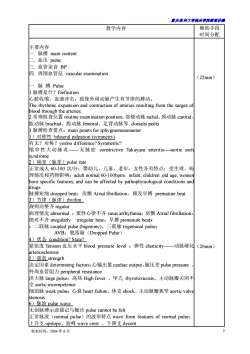
露庆医科大学临床半院载案讲满 教学内容 捕助王段 时间分配 主要内容 .脉搏main content 血压pulse 三.血管杂音BP 四.周围血管征vascular examination (22min) 脉搏Pulse 1,脉搏是什?Definition 心脏收缩,血液冲击,致使外周动脉产生有节律的搏动。 The rhythmic expansion and contraction of arteries resulting from the surges of blood through the arteries. 2.常规检查位置routine examination position:部桡动脉radial、颈动脉carotid 肱动脉brachial、股动脉femoral、.足背动脉等dorsalis pedis B.脉搏检查要点:main points for sphygmomanometer:. 对称?yeo?Symmetric2 缩窄性大动脉炎一无脉症constrictive Takayasu arteritis-aortic arch yndrome 2)频率(脉率)pulse rate 正常成人60-100次份:婴幼儿、儿童、老年、女性各有特点:受生理、病 pm:infant,children old as a 搏短绌dr 节律(脉 ed beat:房颤Atrial fibrillation、频发早搏premature beat 规则而整齐regular 病理情况abnormal:窦性心律不齐sinus arrhythmia:房颤Atrial fibrillation 绝对不齐irregularly irregular beat:早搏premature beats -脉counled pulse (hi geminy) 三联脉trigeminal pulse AVB:脱落脉(Dropped Pulse 4)状态condition?State2 紧张度Tension血压水平blood pressure level:弹性elasticity- -动脉硬化(20min) arteriosclerosis 5)强弱strength 决定因素determining factors:心输出量cardiac output、脉压差pulse pressure 外周血管阻力periph istance 洪大脉large pulse:高热High fever、甲亢thyrotoxicosis、主动脉瓣关闭不 全aortic incompetence 细弱脉weak pulse:心衰heart failure、休克shock、主动脉瓣狭窄aortic valv: stenosis 6)脉波pulse wave 无创脉搏示波描记与触诊pulse cannot be felt 正常脉波(normal pulse)的波形特点 form features of normal pulse 上升支pop,波峰wave crest、下降支decent 制表时间:2004年8月
重庆医科大学临床学院教案讲稿 制表时间:2004 年 8 月 2 教学内容 辅助手段 时间分配 主要内容 一. 脉搏 main content 二. 血压 pulse 三. 血管杂音 BP 四. 周围血管征 vascular examination 一. 脉 搏 Pulse 1.脉搏是什?Definition 心脏收缩,血液冲击,致使外周动脉产生有节律的搏动。 The rhythmic expansion and contraction of arteries resulting from the surges of blood through the arteries. 2.常规检查位置 routine examination position:部桡动脉 radial、颈动脉 carotid、 肱动脉 brachial、股动脉 femoral、足背动脉等 dorsalis pedis 3.脉搏检查要点:main points for sphygmomanometer: 1)对称性 bilateral palpation (symmetry) 有无?对称?yes/no difference? Symmetric? 缩窄性大动脉炎——无脉症 constrictive Takayasu arteritis-aortic arch syndrome 2)频率(脉率)pulse rate 正常成人 60-100 次/分;婴幼儿、儿童、老年、女性各有特点;受生理、病 理情况和药物影响;adult normal 60-100bpm;infant, children ,old age, women have specific features; and can be affected by pathophysiological conditions and drugs. 脉搏短绌 dropped beat:房颤 Atrial fibrillation、频发早搏 premature beat 3)节律(脉律)rhythm 规则而整齐 regular 病理情况 abnormal :窦性心律不齐 sinus arrhythmia;房颤 Atrial fibrillation: 绝对不齐 irregularly irregular beat;早搏 premature beats :二联脉 coupled pulse (bigeminy)、三联脉 trigeminal pulse; AVB:脱落脉(Dropped Pulse) 4)状态 condition? State? 紧张度 Tension 血压水平 blood pressure level ;弹性 elasticity——动脉硬化 arteriosclerosis 5)强弱 strength 决定因素 determining factors:心输出量 cardiac output、脉压差 pulse pressure 、 外周血管阻力 peripheral resistance 洪大脉 large pulse:高热 High fever 、甲亢 thyrotoxicosis、主动脉瓣关闭不 全 aortic incompetence 细弱脉 weak pulse:心衰 heart failure、休克 shock、主动脉瓣狭窄 aortic valve stenosis 6)脉波 pulse wave 无创脉搏示波描记与触诊 pulse cannot be felt 正常脉波(normal pulse)的波形特点 wave form features of normal pulse: 上升支 upslope、波峰 wave crest 、下降支 decent (22min) (20min)
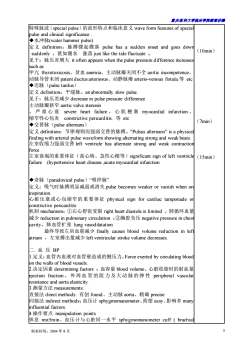
置庆医科大学脑床半院藏未讲满 特殊脉波(special pulse)的波形特点和临床意义wave form features of special 定义:脉搏骤起骤落pulse has a sudden onset and goes dow 犹如潮水涨落just like the tide fluctuate。 (10min)】 suddenly 见于:脉压差增大it often appears when the pulse pressure difference increase such as 甲亢thyrotoxicosis、贫血anemia、主动脉瓣关闭不全aortic incompetence. 动脉导管未闭patent ductus arteriosus、动静脉瘘arterio-venous fistula.等etc ◆迟脉(pulse tardus) 定义de 平缓脉。an abnormally slow pulse 见于:脉压差减少decrease in pulse pressure difference 主动脉瓣狭窄aortic valve stenosis 严重心衰severe heart failure、心肌梗塞myocardial infarction 缩窄性心包炎constrictive pericarditis.等etc ◆交替脉(pulse lt (7min) 定义definition:节律规则而强弱交替的脉搏。"Pulsus altemans"is a physica I pulse waveform showing alternating strong and weak beats orce 左室衰竭的重要体征(高心病、急性心梗等)significant sign of left ventricle (15min) failure (hypertensive heart disease ,acute myocardial infarction ◆奇脉(paradoxical pulse)“吸停脉' 定义:吸气时脉搏明显减弱或消失pulse becomes weaker or vanish when or 心脏压塞或心包缩窄的重要体征physical sign for cardiac tamponade o 机制cchanism:O右心舒张受限i heartiassimied,肺循环血司 减少reduction in p叫 ;②胸腔负压negative pressure in che 最终导致左房血量减少finally causes blood volume reduction in lef atrium,左室搏出量减少left ventricular stroke volume decreases. 血压BP l.定义:血管内血液对血管壁造成的侧压力Force exerted by circulating bloo valls of blood v ,血容量blood volume 、心脏收缩时的射血耳 ejection fraction、 外周血管的阻力及大动脉的弹性peripheral vascula esistance and aorta elasticity. 3.测匣万法measurements: 直接法direct methods:有创found、主动脉aota、精确precise 间接法indirect methods:血压计sphygmomanometer、简便eay、影响多man nfluential factors 休息 片安点4时同一水平spvmommeter cuff(brachial est5min、 制表时间:2004年8月
重庆医科大学临床学院教案讲稿 制表时间:2004 年 8 月 3 特殊脉波(special pulse)的波形特点和临床意义 wave form features of special pulse and clinical significance . ◆水冲脉(water hammer pulse) 定义 definition:脉搏骤起骤落 pulse has a sudden onset and goes down suddenly ,犹如潮水 涨落 just like the tide fluctuate 。 见于:脉压差增大 it often appears when the pulse pressure difference increases such as 甲亢 thyrotoxicosis、贫血 anemia、主动脉瓣关闭不全 aortic incompetence、 动脉导管未闭 patent ductus arteriosus、动静脉瘘 arterio-venous fistula.等 etc ◆迟脉(pulse tardus) 定义 definition:平缓脉。an abnormally slow pulse. 见于:脉压差减少 decrease in pulse pressure difference 主动脉瓣狭窄 aortic valve stenosis 、严重心衰 severe heart failure 、 心 肌 梗 塞 myocardial infarction 、 缩窄性心包炎 constrictive pericarditis. 等 etc ◆交替脉(pulse alternans) 定义 definition:节律规则而强弱交替的脉搏。''Pulsus alternans'' is a physical finding with arterial pulse waveform showing alternating strong and weak beats. 左室收缩力强弱交替 left ventricle has alternate strong and weak contraction force 左室衰竭的重要体征(高心病、急性心梗等)significant sign of left ventricle failure (hypertensive heart disease ,acute myocardial infarction ◆奇脉(paradoxical pulse)“吸停脉” 定义:吸气时脉搏明显减弱或消失.pulse becomes weaker or vanish when on inspiration. 心脏压塞或心包缩窄的重要体征 physical sign for cardiac tamponade or constrictive pericarditis 机制 mechanism:①右心舒张受限 right heart diastole is limited ,肺循环血量 减少 reduction in pulmonary circulation ;②胸腔负压 negative pressure in chest cavity,肺血管扩张 lung vasodilatation 最终导致左房血量减少 finally causes blood volume reduction in left atrium ,左室搏出量减少 left ventricular stroke volume decreases. 二. 血 压 BP 1.定义:血管内血液对血管壁造成的侧压力。Force exerted by circulating blood on the walls of blood vessels. 2.决定因素 determining factors :血容量 blood volume、心脏收缩时的射血量 ejection fraction、 外周血 管的阻 力及大动 脉的弹 性 peripheral vascular resistance and aorta elasticity. 3.测量方法 measurements: 直接法 direct methods: 有创 found、主动脉 aorta、精确 precise 间接法 indirect methods:血压计 sphygmomanometer、简便 easy、影响多 many influential factors. 4.操作要点 manipulation points 休息 rest5min、血压计与心脏同一水平 sphygmomanometer cuff ( brachial (10min) (7min) (15min)
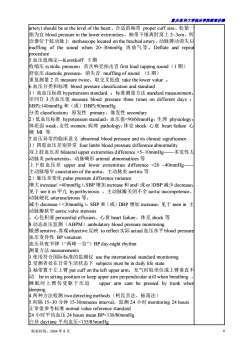
露庆医科大学临床半蕊藏素讲满 artery)should be at the level of the heart、合适的袖带proper cuff size、松紧 指为宜bood ure in the lower extremities 袖带下缘离肘窝上2~3c 诊器位于肱动脉上效h、动脉搏动消失后 muffling of the sound when20-30mmHg再放气等。Deflate and repea procedure 5.血压值确定一Korotkoff5期 收缩压systolic pressure:首次响亮拍击音first loud tapping sound(1期) 舒张压diastolic pressure:消失音muffling of sound(5期) 重复测量2次 twice,取交叉低值take the ower value 6.血压分类和标准blood pressure classification and standard 1)高血压标准hypertension standard:标准测量方法standard measurement H非同日3次血压值measure blood pressure three times on different days sBp>140mmHg和(或)DBP>g0mmHe 分类classification:原发性primary、继发性secondar 低血压标准:血压值<90/60mmHg:生理physiology 体质弱weak、女性women;病理pathology:休克shock心衰heart failure心 梗MI等 7.血压异常的临床意义abnormal blood pressure and its clinical significance 1)四肢血压差别异常four limbs blood 双上肢血压差 5-10mmHg- 多发性 动脉炎polyarteritis、动脉畸形arterial abnormalities等 上下肢血压差upper and lower extremities difference20~40mmHg 主动脉缩窄coarctation of the aorta、主动脉炎aortitis等 2)脉压差变化pulse pressure difference variance 增大increas mHg):SBP增加 se和and(或or)DBP减少decrease 见于see it in甲亢hyperthyreosis、主动脉兼关闭不全aortic incompetence, 动脉使化arteriosclerosis等。 减小decrease(<30mmHg):SBP和(或)DBP增加increase:见于seen in主 动脉瓣狭窄aortic valve stenosis 心、句积液 ericardial effusion、心衰heart failure、休克shock等 8.动态血压监测(ABPM)ambulatory blood pressure monitoring 敏感senstive、.客观objective反映to reflect实际actual血压水平blood pressur: 血压变异性BP variation 血压昼夜节律(“两峰一谷”)BPday-night rhythm 品方法measun .使用符合国际标准的监测仪use the standard 受测者处在日常生活状态下subjects must be in daily life state 3.袖带置于左上臂put cuff on the left upper arm,充气时取坐位或上臂垂直不 be in sitting position or keep upper arm perpendicular still when breathing 睡眠时上臂勿受躯干压迫 upper arm cant be pressed by trunk wh 树种方法检测(柯氏音法,报荡法) 隔15-30分钟15-30,监测24小时monitoring24 hours 正常值参考标准normal value reference standard 24小时平均血压24 hours mean BP<130/80 mmHg 白昼daytime平均血压<135/85mmHg 制表时间:2004年8月
重庆医科大学临床学院教案讲稿 制表时间:2004 年 8 月 4 artery) should be at the level of the heart、合适的袖带 proper cuff size、松紧一 指为宜 blood pressure in the lower extremities、袖带下缘离肘窝上 2~3cm、听 诊器位于肱动脉上 stethoscope located on the brachial artery、动脉搏动消失后 muffling of the sound when 20~30mmHg 再放气等。Deflate and repeat procedure 5.血压值确定—Korotkoff 5 期 收缩压 systolic pressure:首次响亮拍击音 first loud tapping sound(1 期) 舒张压 diastolic pressure:消失音 muffling of sound (5 期) 重复测量 2 次 measure twice,取交叉低值 take the lower value 。 6.血压分类和标准 blood pressure classification and standard 1)高血压标准 hypertension standard :标准测量方法 standard measurement; 非同日 3 次血压值 measure blood pressure three times on different days ; SBP≥140mmHg 和(或)DBP≥90mmHg 分类 classification:原发性 primary、继发性 secondary 2)低血压标准 hypotension standard:血压值5~10mmHg——多发性大 动脉炎 polyarteritis、动脉畸形 arterial abnormalities 等 上下肢血压差 upper and lower extremities difference 40mmHg):SBP 增加 increase 和 and(或 or)DBP 减少decrease; 见于 see it in 甲亢 hyperthyreosis 、主动脉瓣关闭不全 aortic incompetence、 动脉硬化 arteriosclerosis 等。 减小 decrease(<30mmHg):SBP 和(或)DBP 增加 increase;见于 seen in 主 动脉瓣狭窄 aortic valve stenosis 、心包积液 pericardial effusion、心衰 heart failure、休克 shock 等 8.动态血压监测(ABPM)ambulatory blood pressure monitoring 敏感senstive、客观objective反映 to reflect 实际 actual血压水平blood pressure 血压变异性 BP variation 血压昼夜节律(“两峰一谷”)BP day-night rhythm 测量方法 measurements 1.使用符合国际标准的监测仪 use the international standard monitoring 2.受测者处在日常生活状态下 subjects must be in daily life state 3.袖带置于左上臂 put cuff on the left upper arm,充气时取坐位或上臂垂直不 动 be in sitting position or keep upper arm perpendicular still when breathing , 睡眠时上臂勿受躯干压迫 upper arm cant be pressed by trunk when sleeping. 4.两种方法检测 two detecting methods(柯氏音法、振荡法) 5.间隔 15~30 分钟 15-30minutes interval,监测 24 小时 monitoring 24 hours 正常值参考标准 normal value reference standard 24 小时平均血压 24 hours mean BP<130/80mmHg 白昼 daytime 平均血压<135/85mmHg
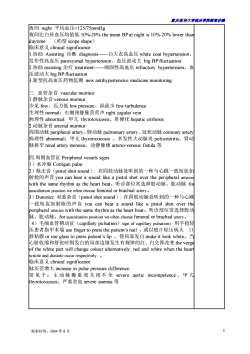
重庆医科大半临床半院载案讲满 夜间night平均血压<125/75mmHg 夜间比白昼血压均值低10%20%h: mean BP at night is 10%-20%lower th (杓型 scope shape 1.协助Assisting诊断diagnosis- -白大衣高血压white coat hypertension 发作性高血压paroxysmal hypertension、血压波动大big BP fluctuation 2协助assisting治疗treatment -顽周性高血压refractory hypertension、 油动大hiDDt tion ,新型抗高血压药物监测new antihypertensive medicine monitoring 血管杂音vascular murmur 1.静脉杂音venous murmur 少见few、压力低low pressure、涡流少few turbulence 生理性normal:右侧颈静脉营营声right】 房理性abnomab甲亢山.解化h心is cimthosis 2.动脉杂音arterial murmur 周围动脉peripheral artery、肺动脉pulmonary artery、冠状动脉coronary arter 病理性abnormal::甲亢thyrotoxicosis、多发性大动脉炎polyarteritis、肾动 脉狭窄renal artery stenosis、动静脉痿arterio-venous fistula等 四.周围血管征Peripheral vessels signs 1)水冲脉Corrigan pulse 2)枪击音(pistol shot sound):在四肢动脉处听到的一种与心跳一致短促女 射枪的声音you can hear a sound like a pistol shot over the peripheral arterie with the same rhythm as the heart beat。.听诊部位常选择股动脉、肱动脉fo uscultation position Du eofen choos):在四肢动脉处听到的一种与心跳 (pistol s 致短促如射枪的声音you can hear a sound like a pistol shot over the eripheral arteries with the same rhythm as the heart beat。听诊部位常选择股动 脉、肱a动脉。for auscultation position we often choose femoral or brachial artery.。 4)毛细血管搏动征(capillary pulsation)sign of capillary pulsation:用手指 压患者指甲末端use finger to press the patier ail ,或以玻片轻压病人 唇粘形 使局部发白make it look white, of the white part will change colour alternatively;red and white when the hear ystole and diastole occur respectively 临床意义clinical significance 脉压差增大increase in pulse ssure differenc 常见于:主 脉瓣重度关闭不全 severe aortic incompetence、甲 thyrotoxicosis、严重贫血severe anemia等 制表时间:2004年8月
重庆医科大学临床学院教案讲稿 制表时间:2004 年 8 月 5 夜间 night 平均血压<125/75mmHg 夜间比白昼血压均值低 10%-20% the mean BP at night is 10%-20% lower than daytime. (杓型 scope shape) 临床意义 clinical significance 1.协助 Assisting 诊断 diagnosis——白大衣高血压 white coat hypertension、 发作性高血压 paroxysmal hypertension、血压波动大 big BP fluctuation 2.协助 assisting 治疗 treatment——顽固性高血压 refractory hypertension、血 压波动大 big BP fluctuation 3.新型抗高血压药物监测 new antihypertensive medicine monitoring 三. 血管杂音 vascular murmur 1.静脉杂音 venous murmur 少见 few、压力低 low pressure、涡流少 few turbulence 生理性 normal:右侧颈静脉营营声 right jugular vein 病理性 abnormal: 甲亢 thyrotoxicosis、肝硬化 hepatic cirrhosis 2.动脉杂音 arterial murmur 周围动脉 peripheral artery、肺动脉 pulmonary artery、冠状动脉 coronary artery 病理性 abnormal:甲亢 thyrotoxicosis 、多发性大动脉炎 polyarteritis、肾动 脉狭窄 renal artery stenosis、动静脉瘘 arterio-venous fistula 等 四.周围血管征 Peripheral vessels signs 1)水冲脉 Corrigan pulse 2)枪击音(pistol shot sound): 在四肢动脉处听到的一种与心跳一致短促如 射枪的声音 you can hear a sound like a pistol shot over the peripheral arteries with the same rhythm as the heart beat。听诊部位常选择股动脉、肱动脉 for auscultation position we often choose femoral or brachial artery。 3)Duroziez 双重杂音(pistol shot sound): 在四肢动脉处听到的一种与心跳 一致短促如射枪的声音 you can hear a sound like a pistol shot over the peripheral arteries with the same rhythm as the heart beat。听诊部位常选择股动 脉、肱动脉。for auscultation position we often choose femoral or brachial artery。 4)毛细血管搏动征(capillary pulsation)sign of capillary pulsation:用手指轻 压患者指甲末端 use finger to press the patient’s nail ,或以玻片轻压病人 口 唇粘膜 or use glass to press patient’s lip ,使局部发白 make it look white,当 心脏收缩和舒张时则发白的局部边缘发生有规律的红、白交替改变 the verge of the white part will change colour alternatively; red and white when the heart systole and diastole occur respectively 。 临床意义 clinical significance 脉压差增大 increase in pulse pressure difference 常 见 于 : 主 动 脉 瓣 重 度 关 闭 不 全 severe aortic incompetence 、甲亢 thyrotoxicosis、严重贫血 severe anemia 等
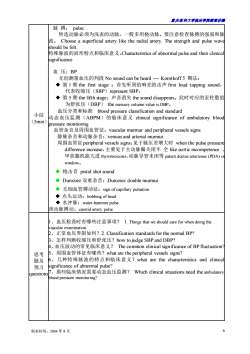
重庆医科大学临床半院煮素讲满 脉博nulse 所选动脉必须为浅表的动脉,一般多用桡动脉。要注意检查脉搏的强弱和脉 啵。 Choos a superficial artery like the radial artery.The strength and pulse wav significance 血压:BP 无创测量血压的判段No sound can be heard-Korotkoff5期法: ◆第1期the first stage:首先听到的响亮拍击声first loud tapping sound, 代表收缩压(SBP) sent SBP: ◆第5期the fifth stage: 音清失。此时对应的汞柱数值 为舒张压(DBP)the mercury coum value is DBP。 小结 血压分类和标准blood pressure classification and standard (5min) 恸态血压监测(ABPM)的临床意义clinical significance of ambulatory blood Inressure monitoring 血管杂音及周围血管征:vascular murmur and peripheral vessels signs ous and ve 曾大时when the pulse pressure dfereenrese,主要见于主动脉据关闭不全ke incompetence 甲状腺机能亢进thyrotoxicosis、.动脉导管未闭等patent ductus arteriosus(PDA)o windowe ◆枪击音pistol shot sound ◆Duroziez双重杂音:Duroziez double murmur ◆毛细血管搏动征:sign of capillary pulsation ◆点头运动:bobbing ofhead ◆水冲脉: wate ammer pulse 颈动脉搏动。carotid artery pulse l、血压检查时有哪些注意事项?L.Things that we should care for when doing the P、 B、怎样判断收缩压和舒张压?how to judge SBP and DBP? 4、血压波动的常见临床意义?The common clinical significance of BP fluctuation? 思考 5、周围血管体征有哪些?what are the peripheral vessels signs? 题及 b、几种特殊脉波的特点和临床意义?what are the characteristics and clinica 预习 questions7 些临床 动态血压监a测?Which need the mbulator d pressure monitoring 制表时间:2004年8月 6
重庆医科大学临床学院教案讲稿 制表时间:2004 年 8 月 6 小结 (5min) 脉 搏: pulse: 所选动脉必须为浅表的动脉,一般多用桡动脉。要注意检查脉搏的强弱和脉 波。 Choose a superficial artery like the radial artery. The strength and pulse wave should be felt. 特殊脉波的波形特点和临床意义。Characteristics of abnormal pulse and their clinical significance 血 压:BP 无创测量血压的判段 No sound can be heard - Korotkoff 5 期法: ◆ 第 1 期 the first stage :首先听到的响亮拍击声 first loud tapping sound, 代表收缩压(SBP)represent SBP; ◆ 第 5 期 the fifth stage:声音消失 the sound disappears。此时对应的汞柱数值 为舒张压(DBP) the mercury column value is DBP。 血压分类和标准 blood pressure classification and standard 动态血压监测(ABPM)的临床意义 clinical significance of ambulatory blood pressure monitoring 血管杂音及周围血管征:vascular murmur and peripheral vessels signs 静脉杂音和动脉杂音;venous and arterial murmur 周围血管征peripheral vessels signs:见于脉压差增大时 when the pulse pressure difference increase,主要见于主动脉瓣关闭不 全 like aortic incompetence 、 甲状腺机能亢进 thyrotoxicosis、动脉导管未闭等 patent ductus arteriosus (PDA) or window。 ◆ 枪击音 pistol shot sound ◆ Duroziez 双重杂音;Duroziez double murmur ◆ 毛细血管搏动征;sign of capillary pulsation ◆ 点头运动;bobbing of head ◆ 水冲脉;water-hammer pulse. 颈动脉搏动。carotid artery pulse 思考 题及 预习 questions 1、血压检查时有哪些注意事项? 1. Things that we should care for when doing the vascular examination. 2、正常血压界限如何?2. Classification standards for the normal BP? 3、怎样判断收缩压和舒张压?how to judge SBP and DBP? 4、血压波动的常见临床意义? The common clinical significance of BP fluctuation? 5、周围血管体征有哪些?what are the peripheral vessels signs? 6、几种特殊脉波的特点和临床意义?what are the characteristics and clinical significance of abnormal pulse? 7、那些临床情况需要动态血压监测? Which clinical situations need the ambulatory blood pressure monitoring?
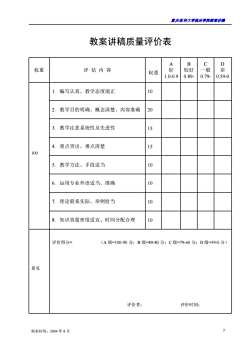
重庆医科大半临床半院载案讲满 教案讲稿质量评价表 B C D 权重 评估内容 权重 较好 1.0-0.90.89 0.79- 0.59-0 编写认真、教学态度端正 教学目的明确、概念清楚、内容准确 20 3.教学注意系统性及先进性 15 4. 重点突出、难点清楚 15 100 5. 教学方法、手段适当 10 6. 运用专业外语适当、准确 10 理论联系实际、举例恰当 10 8.知识容量密度适宜、时间分配合理 评价得分 (A级=100-90分:B级=89-80分:C级=79-60分:D级=59-0分 意见 评价者: 评价时间: 制表时间:2004年8月
重庆医科大学临床学院教案讲稿 制表时间:2004 年 8 月 7 教案讲稿质量评价表 权重 评 估 内 容 权重 A 好 1.0-0.9 B 较好 0.89- C 一般 0.79- D 差 0.59-0 100 1. 编写认真、教学态度端正 10 2. 教学目的明确、概念清楚、内容准确 20 3. 教学注意系统性及先进性 15 4. 重点突出、难点清楚 15 5. 教学方法、手段适当 10 6. 运用专业外语适当、准确 10 7. 理论联系实际、举例恰当 10 8. 知识容量密度适宜、时间分配合理 10 意见 评价得分= (A 级=100-90 分;B 级=89-80 分;C 级=79-60 分;D 级=59-0 分) 评价者: 评价时间:
按次数下载不扣除下载券;
注册用户24小时内重复下载只扣除一次;
顺序:VIP每日次数-->可用次数-->下载券;
- 重庆医科大学:《诊断学》课程教学资源(授课教案)15 超声心动图检查.doc
- 重庆医科大学:《诊断学》课程教学资源(授课教案)13 循环系统主要症状与体征.doc
- 重庆医科大学:《诊断学》课程教学资源(授课教案)20 呼吸系统症状和体征.doc
- 重庆医科大学:《诊断学》课程教学资源(授课教案)11 心脏检查.doc
- 重庆医科大学:《诊断学》课程教学资源(授课教案)14 心电图.doc
- 重庆医科大学:《诊断学》课程教学资源(授课教案)06 腹泻.doc
- 重庆医科大学:《诊断学》课程教学资源(授课教案)05 腹痛.doc
- 重庆医科大学:《诊断学》课程教学资源(授课教案)07 黄疸.doc
- 重庆医科大学:《诊断学》课程教学资源(授课教案)02 水肿.doc
- 重庆医科大学:《诊断学》课程教学资源(授课教案)01 绪论与问诊.doc
- 重庆医科大学:《诊断学》课程教学资源(授课教案)08 腹部检查.doc
- 重庆医科大学:《诊断学》课程教学资源(授课教案)09 病历与诊断.doc
- 重庆医科大学:《诊断学》课程教学资源(授课教案)03 呕血.doc
- 重庆医科大学:《诊断学》课程教学资源(授课教案)04 便血.doc
- 重庆医科大学:《实验诊断学》课程教学资源(PPT课件)第八讲 脑脊液常规及生殖系统检查.ppt
- 重庆医科大学:《实验诊断学》课程教学资源(PPT课件)第七讲 大便常规、免疫学检查及心肌标志物检查.ppt
- 重庆医科大学:《实验诊断学》课程教学资源(PPT课件)第六讲 肾功能检查(主讲:唐敏).ppt
- 重庆医科大学:《实验诊断学》课程教学资源(PPT课件)第四讲 血栓与出血检查(主讲:胥文春).ppt
- 重庆医科大学:《实验诊断学》课程教学资源(PPT课件)第三讲 骨髓细胞学检查、血型与输血.ppt
- 重庆医科大学:《实验诊断学》课程教学资源(PPT课件)第一讲 总论及血液一般检查(上).ppt
- 重庆医科大学:《诊断学》课程教学资源(授课教案)10 发热.doc
- 重庆医科大学:《诊断学》课程教学资源(授课教案)19 胸部检查.doc
- 重庆医科大学:《诊断学》课程教学资源(授课教案)18 呼吸困难.doc
- 重庆医科大学:《诊断学》课程教学资源(授课教案)16 咳嗽、咳痰.doc
- 重庆医科大学:《诊断学》课程教学资源(授课教案)17 咯血.doc
- 医学临床本科《MRI诊断学》课程教学大纲 Magnetic Resonance Imaging Diagnosis.doc
- 医学临床本科《影像诊断学》课程教学大纲 medical imaging(包含MRI部分).doc
- 医学影像本科《MRI诊断学》课程教学大纲(Magnetic Resonance Imaging Diagnosis).doc
- 石河子大学:《MRI诊断学》课程教学资源(讲稿,共五章).doc
- 石河子大学:《MRI诊断学》课程教学课件(PPT讲稿)第一章 MRI总论.ppt
- 石河子大学:《MRI诊断学》课程教学课件(PPT讲稿)第三章 呼吸系统 3.1 3.2 正常及异常.ppt
- 石河子大学:《MRI诊断学》课程教学课件(PPT讲稿)第三章 呼吸系统 3.3 支气管扩张及肺部炎症.ppt
- 石河子大学:《MRI诊断学》课程教学课件(PPT讲稿)第三章 呼吸系统 3.4 肺结核.ppt
- 石河子大学:《MRI诊断学》课程教学课件(PPT讲稿)第三章 呼吸系统 3.5 肺肿瘤.ppt
- 石河子大学:《MRI诊断学》课程教学课件(PPT讲稿)第三章 呼吸系统 3.6 纵膈疾病.ppt
- 石河子大学:《MRI诊断学》课程教学课件(PPT讲稿)第四章 循环系统(冠脉及主动脉).ppt
- 石河子大学:《MRI诊断学》课程教学课件(PPT讲稿)第五章 消化系统和腹膜腔 5.2 急腹症.ppt
- 石河子大学:《MRI诊断学》课程教学课件(PPT讲稿)第五章 消化系统和腹膜腔 5.3 肝脏.ppt
- 石河子大学:《MRI诊断学》课程教学课件(PPT讲稿)第五章 消化系统和腹膜腔 5.4 胆道系统疾病.ppt
- 石河子大学:《MRI诊断学》课程教学课件(PPT讲稿)第五章 消化系统和腹膜腔 5.5 胰腺.ppt
